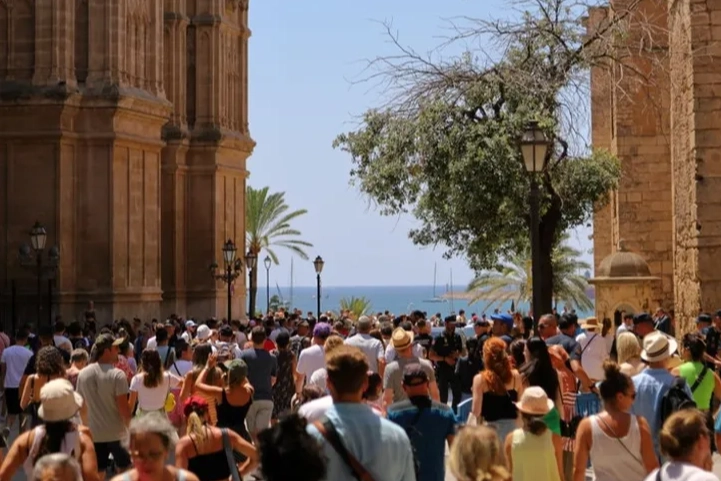In many cities across Europe, local people are protesting against excessive tourism and organizing demonstrations. The global middle class is shifting towards Europe, which they find more affordable. So, what is the reason behind this tourism anger across the continent? The Times analyzed it.

Lauterbrunnen, a Swiss village overlooking the Bernese Alps, blames TikTok for overtourism. Along the valley's crowded paths, selfie sticks are raised as if going into battle, and long lines form in front of waterfalls. A drone buzzes overhead. According to local resident Alexis Heuser, the area has become overcrowded and commercialized in recent years.
This is a familiar story across Europe. Tourists, many of whom are Americans with strong dollars, are flocking to the continent at surprising rates: the number of US visitors to the EU is 65% higher than a decade ago. But it's not just Americans; the wealthy middle classes of China, India, and Brazil are also flooding in. Last year, there were 709 million overseas visitors, a 22% increase from a decade ago. As the share of global wealth shifts from Europe to China, India, and the Gulf, the allure of Europe's beaches, museums, churches, designer shops, and deep cultural heritage has proven irresistible, especially after the lifting of pandemic restrictions.
Despite economic and geopolitical setbacks, Europe's appeal continues to grow. Mallorca will break its tourist record for the third consecutive year. In 2022, the island had 17 million visitors. This year, 20 million visitors are expected, which is about 22 times the population of Mallorca.
Measures have been taken across the continent
There has been a strong backlash against overtourism in Europe for years. Venice has taken measures to ban cruise ships and, this year, began charging a €5 entry fee on the busiest days. Last spring, Amsterdam announced that "overtourism would be completely banned" by 2035, which means banning cruise ships, new hotels, and more than 20 million overnight stays by tourists per year, according to local government. Similar anti-tourism movements exist in Athens, Lisbon, Venice, and Barcelona, as well as much of Spain, including Mallorca and Tenerife. But what is the reason behind this opposition movement? Are those protesting against tourism self-sabotaging or honest citizens trying to protect themselves?
Social media tourism
The real game-changer has been the emergence of cheap air travel. It has been 30 years since the EasyJet revolution opened Europe up to all kinds of vacations. In 1955, a one-way ticket from New York to London on Trans World Airlines cost £222, or £2,561 in today's money. Now, the same journey costs around £390. Thanks to Airbnb, accommodation is often more flexible and affordable. Add to this social media tourism. With the prevalence of Instagram and TikTok, many more people are eager to visit the same places, eat at the same restaurants, or take photos at the same waterfall.
Lauterbrunnen stands out. During the peak season, the village's population of 2,400 can rise to 6,000. It's hard to reach Venice levels, but it still struggles under the load. In some parts of the road, there is no sidewalk, forcing people to walk alongside traffic. Signs on houses are filled with warnings like "BE CAREFUL" and "NO PHOTOGRAPHY." Last month, restless villagers considered introducing a "day-tripper tax." As summer temperatures regularly exceed 40C in Southern Europe, Instagram-worthy Alpine valleys in Switzerland and Austria are becoming more popular. Yet there is a discrepancy here. Lauterbrunnen is one of many places that both court and oppose mass tourism.
Cost of living and housing crisis
The loud anti-tourism movements in Europe have a populist tone, reflecting frustrations over the cost of living and especially housing. Young Europeans, in particular, do not seem pleased with their continent turning into a giant museum. The Less Tourism, More Life campaign group in Mallorca follows a similar movement in the Canary Islands, the center of Spanish anti-tourism. Pere Joan, a 25-year-old student from Mallorca, says the group has increased protests this summer because the situation is no longer sustainable. Joan said they unfurled banners on beaches for beach occupation, surprising tourists. While Mallorca survives on tourism, Joan said the wealth is unequally distributed and does not benefit the island's residents.